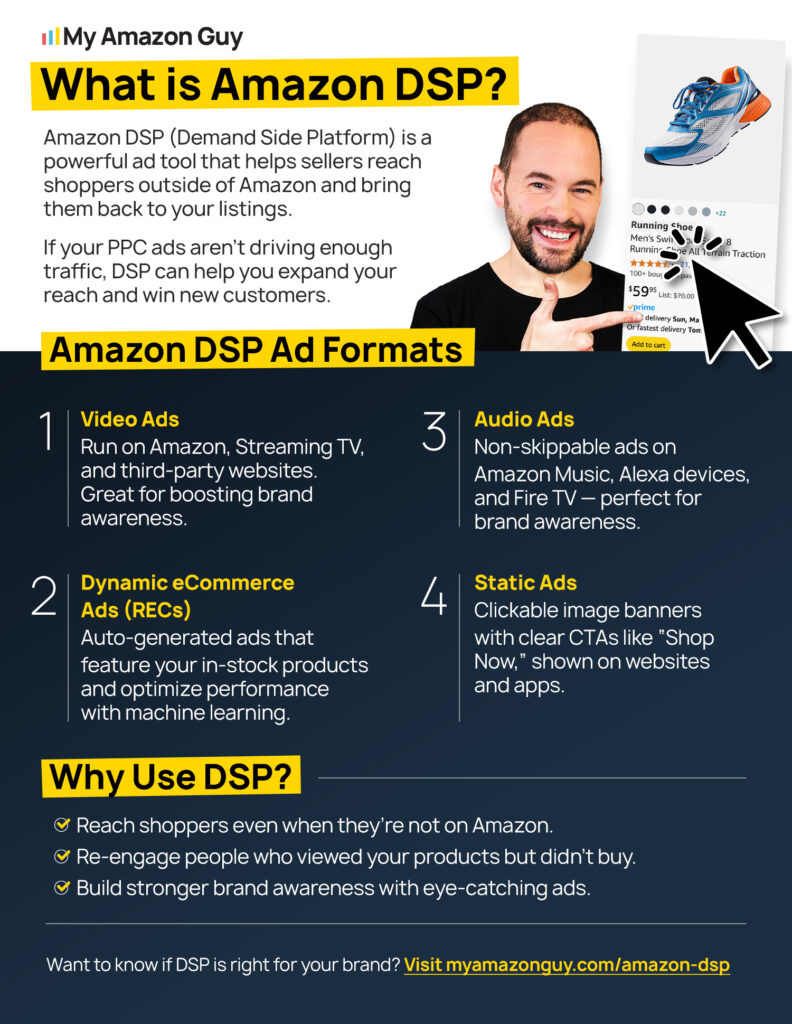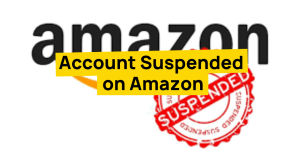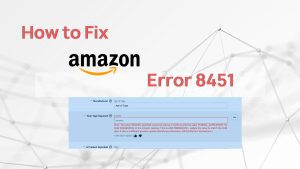Are you looking for ways to advertise your Amazon listings? Try Amazon DSP ads to reach potential buyers both on and off Amazon, increasing visibility and driving more sales.
As an Amazon seller, making your products visible to shoppers is crucial. If customers can’t see your products, they essentially don’t exist in the marketplace.
Running advertisements is one of the most effective ways to ensure your products get noticed. Among the different ad options, Amazon DSP ads stand out as a powerful tool for expanding your reach.
Unlike traditional PPC ads, DSP ads allow you to target shoppers beyond Amazon’s platform. These ads appear across websites, mobile apps, and even video content, helping you connect with more potential customers.
But do sellers really need these ads? In this blog, our Amazon agency will explain why running Amazon DSP ads is essential for growing your business and staying ahead of the competition.
Table of Contents
What Is Amazon DSP and How Does It Work?
Amazon DSP (Demand-Side Platform) is an advertising solution that helps sellers and brands reach shoppers beyond Amazon’s website. It allows advertisers to place display and video ads across Amazon-owned sites, third-party websites, mobile apps, and streaming platforms.
Traditional Amazon PPC ads require shoppers to be searching for your products but DSP ads don’t. Instead, they target potential customers based on browsing behavior, shopping history, and other data to increase brand awareness and drive sales.
Amazon DSP offers different ad formats to engage audiences. These include video ads on streaming services, dynamic eCommerce ads that showcase multiple products, audio ads on Amazon Music, and static image ads with direct “Shop Now” buttons.
Because Amazon DSP works with both Amazon sellers and non-sellers, it’s a great tool for businesses looking to expand their reach. By using Amazon’s rich shopper data, these ads help brands connect with the right audience at the right time.
Why You Need to Run Amazon DSP Ads
Amazon DSP helps sellers reach more shoppers and grow their business beyond regular Amazon ads. To better understand why Amazon DSP is worth using, here are the key reasons sellers should consider running these ads.
1. Access to Amazon’s First-Party Data
Amazon DSP gives sellers a major advantage by using Amazon’s own shopper data for targeting. Instead of relying on what people say they like, DSP tracks real browsing and purchase behavior.
This data enables highly accurate targeting based on recent searches and long-term shopping habits. For example, if someone recently searched for workout supplements, they may see ads for protein shakes.
Unlike platforms like Facebook, which rely on user-stated interests, Amazon DSP uses real shopping actions. This leads to better ad targeting, higher conversion rates, and smarter ad spending.
2. Targeting Specific Audiences
Amazon DSP helps sellers reach new potential customers by using advanced audience segmentation. Sellers can target users based on demographics, shopping behaviors, and interests.
For example, lifestyle audiences include fitness enthusiasts, while in-market audiences are actively searching for similar products. Another powerful tool is contextual targeting, which places ads on relevant content, ensuring they reach shoppers in the right mindset.
Additionally, demographic filters allow advertisers to refine their audience based on age, income, or household size. These strategies help expand reach and bring new customers into the sales funnel.
3. Full-Funnel Advertising
Amazon DSP allows sellers to target customers at every stage of the buying journey. At the top of the funnel, demographic targeting helps build brand awareness by reaching broad audiences who may not know about a product.
In the middle of the funnel, DSP targets shoppers who are researching and comparing options. Strategies like competitor and contextual targeting ensure ads reach potential buyers actively considering a purchase.
At the bottom of the funnel, DSP focuses on retargeting to drive conversions. By covering all funnel stages, sellers can create a complete advertising strategy that nurtures customers from discovery to purchase.
4. Retargeting and Cross-Selling
Amazon DSP excels at re-engaging shoppers who have already interacted with your brand. Retargeting allows sellers to show ads to users who viewed a product but didn’t purchase, reminding them to complete their order.
Cross-selling helps sellers increase order value by advertising complementary products. For instance, if a customer buys a coffee maker, they might see ads for coffee beans or filters.
ASIN targeting plays a crucial role here, enabling sellers to promote related products based on past purchases. These strategies keep your brand top-of-mind and maximize conversions by focusing on shoppers already interested in your products.
5. Complementary to PPC
If you’re already using Amazon PPC campaigns, you might think it’s enough to drive sales, but sometimes that is not the case. While PPC captures shoppers actively searching for your product, it doesn’t reach those who haven’t started searching yet.
Amazon DSP fills this gap by building brand awareness and re-engaging past visitors. It allows you to show display and video ads to potential customers based on their browsing habits, even outside of Amazon.
By combining PPC’s search-driven strategy with DSP’s audience-based approach, you create a more complete marketing funnel. This ensures your brand stays visible to both active and passive shoppers, leading to more conversions.
How to Get Started with Amazon DSP Ads
Amazon DSP ads offer powerful targeting and retargeting capabilities that can help grow your business. If you’re considering using DSP, the good news is that getting started is straightforward, as long as you meet the eligibility requirements and follow the right steps to set up your campaign.
Amazon DSP Eligibility Requirements
Before setting up an Amazon DSP campaign, you must meet specific eligibility requirements. While Amazon DSP is a powerful tool, it’s not available to every advertiser, and understanding the qualifications will help you determine if it’s the right fit for your business.
- Who Can Use It: Both Amazon sellers and non-sellers, including brands, agencies, and tool providers.
- Service Options: Self-service (full control, requires expertise) or managed-service (Amazon handles it, with a high minimum spend).
- Budget: Managed-service requires around $50,000, while self-service typically needs a minimum budget of $10,000–$15,000 per month, depending on the DSP provider.
- Compliance: Ads must follow Amazon’s policies.
- PPC Experience: Not required, but this is highly recommended for better results.
How to Set Up an Amazon DSP Campaign
Setting up an Amazon DSP campaign requires a structured approach to ensure effectiveness. Whether using the self-service or managed-service option, advertisers must follow a step-by-step process to launch and optimize their campaigns.
Step 1: Set Up Your DSP Account and Advertiser Profile
- Access Amazon DSP and log in to the DSP Manager.
- Select the seller account associated with the campaign.
- Create advertiser profiles for each country you plan to target.
Step 2: Create an Order (Campaign Level)
- Start a new order, which serves as the campaign framework.
- Name the order descriptively (e.g., “Retargeting Campaign” or “Brand Awareness Campaign”).
- Define key performance indicators (KPIs) like ROAS and select a budget pacing strategy (even pacing or full throttle).
- Set an overall campaign budget and establish spending caps if necessary.
- Choose the products to advertise and set frequency caps to control ad exposure.
Step 3: Create Line Items (Ad Group Level)
- Add line items within the order to structure targeting and placements.
- Name each line item based on its function (e.g., “Mobile Retargeting” or “Desktop Awareness”).
- Specify ad placements, selecting between Amazon’s mobile app, desktop, and external placements.
- Define audience targeting, including product viewers, brand engagers, and competitor audiences.
- Exclude audiences as needed, such as customers who have already purchased.
- Set budget allocations at the line-item level and determine bidding strategies based on CPM.
Step 4: Build and Upload Ad Creatives
- Choose between display, video, or audio ad formats based on campaign objectives.
- Use Amazon’s responsive creative tools or upload custom-designed ads.
- Ensure creatives meet Amazon’s specifications, include clear calls to action, and align with the brand message.
Step 5: Launch and Optimize the Campaign
- Once all settings are configured, submit ads for approval.
- Track key performance metrics like impressions, click-through rates, and conversions.
- Continuously adjust targeting, budget pacing, and ad creatives based on data insights.
Note: Amazon DSP is complex, so working with an experienced full-service Amazon agency is recommended.
Seen a New Seller Central Update? Let Us Know!
Amazon Seller Central constantly updates its interface. If you spot a change we missed, let us know using the form below!
FAQs About Amazon DSP Ads
What are the different Amazon DSP ad types?
Amazon DSP offers various ad formats, including display ads, video ads, and audio ads. Display ads appear on Amazon and third-party websites, while video and audio ads help engage audiences on streaming services.
As a small business owner, should I use Amazon DSP ads?
Amazon DSP is best suited for businesses with a larger budget due to its cost structure, especially for managed-service campaigns. If you have a strong foundation in Amazon PPC and a sufficient advertising budget, DSP can help expand your reach.
Should I use Amazon DSP ads to expand my business?
Yes, if your goal is brand awareness, customer retargeting, or reaching audiences beyond Amazon, DSP can be a powerful tool. It allows precise targeting based on shopping behaviors, making it effective for scaling your business.
What is the difference between Amazon DSP and Sponsored Display ads?
Amazon DSP offers advanced targeting options, including retargeting and lookalike audiences, and allows ads to be placed both on and off Amazon. Sponsored Display is a simpler, self-service ad type within Seller Central with fewer targeting capabilities.
Can non-Amazon sellers use Amazon DSP?
Yes, Amazon DSP is available to brands, agencies, and tool providers, even those who don’t sell products on Amazon. It enables businesses to advertise to Amazon’s audience across various platforms.
Maximize Your Advertising Potential with Amazon DSP
Amazon DSP ads offer sellers a powerful way to reach more shoppers and drive sales beyond traditional PPC campaigns. With advanced targeting options, retargeting capabilities, and full-funnel advertising, sellers can connect with the right audience at every stage of the buying journey.
For those looking to scale their brand and gain a competitive edge, investing in Amazon DSP ads can be a smart move. By leveraging Amazon’s vast first-party data, sellers can maximize ad efficiency, improve conversions, and build long-term customer relationships.
Do you need help setting up and optimizing your Amazon DSP ads? Contact our Amazon agency today and let our experts create data-driven campaigns that drive sales and expand your reach.





